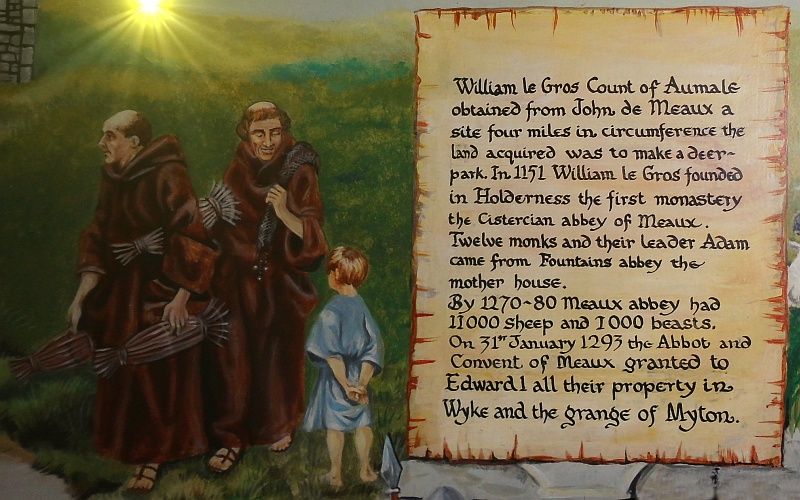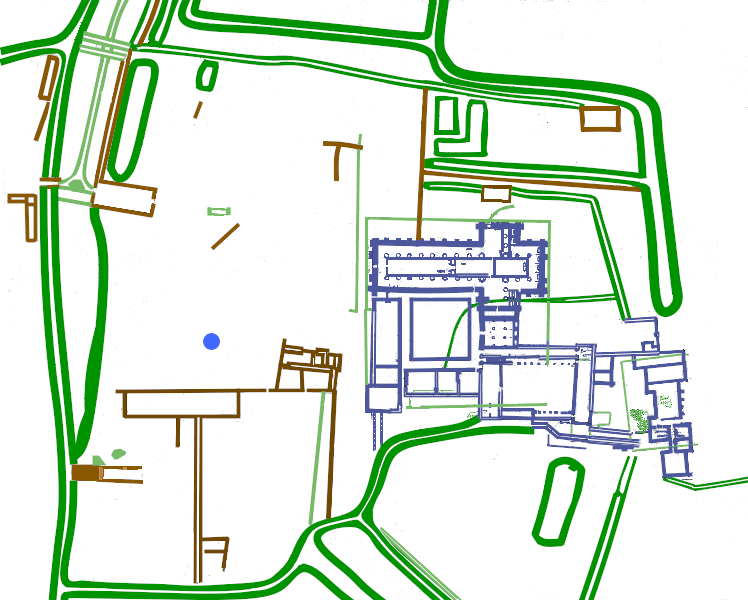
| Meaux (pronounced "mewss") is a tiny hamlet in the East Riding of Yorkshire, about 6.5 miles north of Kingston-upon-Hull city centre and 3.5 miles east of Beverley. It constitutes part of the civil parish of Wawne. The Latin name Melsa may have origins in Old Norse meaning a sandbank-pool. It is the location of the remains of a Cistercian abbey. Melsa has a silent L and A - thus Meaux. Melse is an alternative with silent L and called such in the Domesday Book. |

Image from the entrance area of Black Boy public house High Street, with added sunlight.
|
Text states: "William de Gros Count of Aumale obtained from John de Meaux a site four miles in circumference the land acquired was to make a deer park. In 1151 William de Gros founded in Holderness the first monastery the Cistertian abbey of Meaux. Twelve monks and their leader Adam came from Fountains Abbey the mother house. By 1270-80 Meaux abbey had 11000 sheep and 1000 beasts. On 31st January the Abbot and Convent of Meaux granted to Edward I all their property in Wyke and the grange of Myton." |
| Thomas de Burton (d.1437) (bursar in 1394, abbot from 1396 to 1399) wrote an account of [short name] Chronica Monasterii de Melsa. It was a local Cistercian Abbey. An early version was finished around 1396, and a revised version completed around 1402, with later additions. |
| Meaux abbey was founded in 1150 by William le Gros, Lord of Holderness, as an alternative to missing a Holy Land pilgrimage. Abbot Adam insisted on the site despite the earl wanting it for other uses. Meaux was the last of seven religious houses springing from Fountains Abbey. |
| It developed slowly, but it was dogged by insufficient funds and disputes over land and with authority. Additions included replaced churches, an infirmary (1220-35), a belfty (1249-69) with a great bell called 'Benedict ' hung in it (and more bells later), and a granary. There was a Manor at Wick or Wyke but it was 'surrendered' in 1293 to Edward I who founded Kingston upon Hull. |
| Adam was joined by twelve others by January 1151. In 1249 the number of monks peaked at sixty. There were only 42 monks in 1349 and 28 in 1393, and 25 at the end in 1539. |
| During Hugh de Leven’s time (1339-1349), a lay brethren employed a nude model to carve a crucifix. Considered miraculous, many women visited, yet they cost more to entertain than they gave in donations. When singing 'He hath put down the mighty from their seat', an earthquake threw the monks off their seats, and this was remembered in 1349 as as sign because on 12 August Abbot Hugh and five monks died of the Black Death. |
| Under Henry VIII the whole abbey was demolished and the stones were used to build defences for Hull. A few fragmentary ruins can be seen today. All sorts of dubious origin relics were dispersed that were claimed to have magical qualities. |
| The Leonard Chamberlain Trust owns the land presently. |

Image derived from local map.
Adrian Worsfold
Pluralist - Liberal and Thoughtful